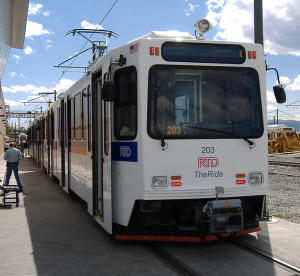Let’s start with same basic “measurable” numbers. In 1990, before Denver built its first light-rail line, the decennial census found that 4.74 percent of the region’s commuters took transit to work. By 2014, the region had four light-rail lines, and the American Community Survey found that the percentage of commuters taking transit to work was all the way up to 4.76 percent.
Yes, that’s a measurable 0.02 percent increase in transit’s share of commuting. If it is a surprise, it is only that it wasn’t a decrease. In 2004, when the region’s voters agreed to raise sales taxes to pay for six new rail lines, they were promised that part of the money would also be used to improve bus service. Instead, rail cost overruns forced a 19 percent decline in vehicle miles of bus service.
Here’s another measurable (but unsurprising) effect: when voters were asked to approve the rail lines, the transit agency told the system would cost $4.7 billion. As Woodard notes, the actual cost so far looks to be $7.6 billion. The new rail line to the airport that opened last month was supposed to cost $350 million. In fact, it cost $1.2 billion. After adjusting for inflation, that’s well over twice as much as projected. We have no idea what first-year ridership will be, but we know that first-year ridership on Denver’s West line was less than 60 percent of the projections.
Denver’s rail construction, says Woodard, was “originally intended to unclog congested highways and defeat a stubborn brown smog that was as unhealthy as it was ugly.” Some people might have thought so, but actual plans written for the rail projects concluded that they would do almost nothing to relieve congestion and would actually make air pollution worse because Denver gets most of its electricity from burning fossil fuels. The most optimistic analysis projected that the new rail lines would take, at most, a half a percent of cars off the road and that the power plants would pollute more than those cars.
Instead of relieving congestion and cleaning the air, Woodard continues, “the new rail system has proven that its greatest value is the remarkable changes in land use its stations have prompted, from revitalizing moribund neighborhoods, like the area around Union Station, to creating new communities.” Say what? Denver taxpayers spent $500 million rebuilding the area around Union Station. One of the new communities mentioned in the article, Stapleton, cost taxpayers another $400 million. These areas were “revitalized” by the taxpayer subsidies, not by the rail lines.

Redevelopment has taken place mainly, if not only, where tax-increment financing and other subsidies have supported it.
Woodard says the trains somehow managed to save Denver from “Houstonization.” That raises another measurable effect of Denver planning: housing costs twice as much as in Houston. According to Caldwell Banker, a 2,200-square-foot house in Houston costs $237,200. That same house in Denver? $542,575. Don’t even ask about Boulder, which is twice as expensive as Denver. The trains didn’t make housing expensive, but the same sort of collectivist planning that prompted the trains also drew the urban-growth boundaries that did make housing expensive.
In the end, the only things the trains saved Denver from were lower taxes and slightly cleaner air. If the region had not built the rail lines but spent a tenth of that money on things that would actually relieve congestion, it would have saved millions of hours of residents’ time per year. The region’s collectivist planning also saved Denver from having housing as affordable as Houston’s.
Politico‘s article is another case of an exuberant journalist reprinting the press releases of government bureaucracies eager to spread the message that Americans can’t be trusted with their own money and so it should be taken from them to be spent by the bureaucracies.
When did the Left become such shills for corporate welfare and bureaucratic bungling?
Randal O’Toole directs the Transportation Policy Center at the Independence Institute, a free market think tank in Denver. A longer version of this piece originally appeared in The Antiplanner blog.


